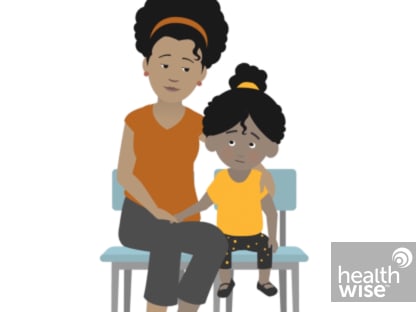Viral Tests
Test Overview
A viral test is done to find infection-causing viruses. Viruses grow only in living cells. Viruses cause disease by destroying or damaging the cells they infect, damaging the body's immune system, changing the genetic material (DNA) of the cells they infect, or causing inflammation that can damage an organ. Viruses cause many types of diseases, such as human immunodeficiency virus (HIV), cold sores, chickenpox, measles, flu (influenza), and some types of cancer.
Viral tests may be done for viruses such as:
- Herpes simplex.
- Chickenpox. This is caused by a form of the herpes virus called varicella-zoster virus (VZV). A viral test may be done to see if a person has formed immunity from having chickenpox or after getting the chickenpox vaccine.
- Respiratory syncytial virus (RSV).
- Epstein-Barr virus.
- Cytomegalovirus (CMV).
- Rotavirus.
- Hepatitis.
- Genital warts (human papillomavirus, or HPV).
- Influenza (flu).
- Human immunodeficiency virus (HIV).
- BK virus.
Different types of samples are used for a viral test. They include blood, urine, stool (feces), organ tissue, spinal fluid, and saliva. The type of sample used for the test depends on the type of infection that may be present.
Why It Is Done
A viral test is done to:
- Find a viral infection that is causing symptoms.
- Check a person after exposure to a virus. For example, a viral test may be done after a health professional is accidentally stuck with a needle containing contaminated blood to see if they became infected with the virus.
- Find a viral infection in a potential blood donor to prevent the donation of infected blood.
- Find a viral infection in an organ to be transplanted.
- Test a pregnant woman who has a high risk of passing a serious viral infection on to her baby.
- Check if a person has immunity to a specific virus.
How To Prepare
Preparations for a viral test depend on the type of infection that may be present and the sample that will be tested. Your health professional will give you any specific instructions before your test.
How It Is Done
Samples can be collected in several ways.
- A health professional uses a needle to take a blood sample, usually from the arm.
- A tissue sample can be taken directly from the infection, such as a throat swab or skin scraping.
- A sample of stool, urine, or nasal washings may be taken.
- A sample of spinal fluid can be taken through a lumbar puncture (spinal tap).
- A biopsy sample may be taken using a needle or other tool.
Watch
How It Feels
The amount of discomfort or pain you feel depends on the method used to collect a sample for the test. Generally, a viral test does not cause pain or the pain goes away after the test.
Risks
In general, the chance of problems from the test depends on the method used to collect a sample for testing. Your doctor can talk to you about any specific risks of the test.
Results
It may take as little as 1 day or up to several weeks to get test results.
The results of some viral tests (antibody or antigen tests) are reported in titers. A titer is a measure of how much the sample can be diluted before the viral antibodies or antigens can no longer be detected.
Depending on the virus, it can take weeks for antibodies to develop after you've been exposed to the virus. In these cases, test results may be negative early in the course of the infection. This is called a false-negative test result. Another blood sample may need to be taken later to check again for a viral infection. Antibody titers that get higher over 3 weeks from the first sample to the second mean the infection occurred recently.
Normal (results that don't show a viral infection are called negative): | Antibody test: | No antibodies to the virus are found. |
|---|---|---|
Viral antigen detection test: | No antigens made by the viral infection are found. | |
Viral culture: | No viral infection is seen in the culture. | |
No viral DNA or RNA is found. | ||
Abnormal (results that show a viral infection are called positive): | Antibody test: | Antibodies to a virus are found. But if you have a second antibody test and the results are not higher than the first test, this may mean the infection occurred in the past and is not a problem now. |
Viral antigen detection test: | Viral antigens are found. | |
Viral culture: | Changes occur in the culture that show a viral infection. | |
Viral DNA or RNA detection test: | Viral DNA or RNA is found. |
Credits
Current as of: September 25, 2025
Author: Ignite Healthwise, LLC Staff
Clinical Review Board
All Ignite Healthwise, LLC education is reviewed by a team that includes physicians, nurses, advanced practitioners, registered dieticians, and other healthcare professionals.
Current as of: September 25, 2025
Author: Ignite Healthwise, LLC Staff
Clinical Review Board
All Ignite Healthwise, LLC education is reviewed by a team that includes physicians, nurses, advanced practitioners, registered dieticians, and other healthcare professionals.

